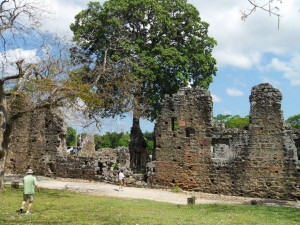Celece Seegmiller at The Spectrum writes of happening in Panama.
Oct. 2 officially kicked off the Panama Canal cruise season with the transit of the Celebrity Millennium. Albano Aguilar, international trade specialist for the Vice Presidency for Planning and Business Development, said more than 200 transits are expected this season, and most major cruise lines offer itineraries of 10 days or more, which include the experience of transiting the Panama Canal. Panama Canal cruises are very popular and, of course, convenient, but there is so much more to do and see in Panama beyond the balcony of a cruise ship or on a one-day shore excursion.
According to the official website of the Republic of Panama, Panama’s geological history is relatively recent. Approximately 3 million years ago, tectonic movements and volcanic activity caused a narrow strip of land to emerge from the sea. This new isthmus separated the Caribbean Sea from the Pacific Ocean, joined the continental masses of North America and South America, gave rise to the Gulf Stream, and transformed the global climate, warming the once-frozen European coasts and creating the conditions for the African savannah to grow. It also initiated a massive interchange of flora and fauna between the north and south, acting as a bridge of life that allowed humans to populate the entire continent.
Ever since, Panama’s geographical position has played a strategic role, in every way. The slender silhouette of the country measures just 80 kilometers (49 miles) across its narrowest waist, permitting the construction of the world’s first transcontinental railroad in 1855 and then the Panama Canal in the early 20th century, forging a nexus once again between the two oceans.
Even before, in the 16th century, Spain had turned Panama into a crossroads between the seas and a significant tradepost within its empire. The riches from the South American Pacific were at first shipped to Panama City, and then carried on mule trains to Nombre de Dios. After the pirate Francis Drake attacked the latter destination, the authorities decided to move the city to a better protected site, choosing Portobelo. This city in turn become very coveted by pirates such as Henry Morgan, who attacked and looted it in 1668, two years before doing likewise at Panama City on the Pacific coast.
Motivated by the winds of freedom blowing from neighboring countries, Panama became independent from Spain in November 1821 and joined instead Gran Colombia, comprised of the countries of Colombia, Venezuela and Ecuador. Panama’s desire to become a free and sovereign republic caused it to separate from Colombia Nov. 3, 1903.
Construction began in 1904 on the Panama Canal, considered the eighth wonder of the modern world, definitively establishing the territory as a place of transit and exchange. Today, Panama is one of the most developed countries of Central America, and with one of the highest levels of economic development and tourism in the Americas. With a healthy and effective democratic system, the country is considered safe, peaceful, prosperous and burgeoning, at the forefront in many sectors. Its economy is based on services provided at tourism sites, the Panama Canal and the international banking center. First-world facilities can be found such as international call centers, modern shopping malls, and excellent professionals and technicians.
Next year marks the 100th anniversary celebration of the Panama Canal, and several tour companies are offering fascinating itineraries that give visitors the opportunity to explore the old and new Panama City, Portobelo, Gamboa Rainforest Resort and Playa Bonita. They include exciting activities like a full canal transit from the Pacific to the Atlantic; seeing the massive construction of the new canal; guided tours with naturalists on Barro Colorado Island in Gatun Lake where guests see tropical birds, tapirs, sloths and monkeys; and a ride on the historic Panama Railroad. Single travelers will appreciate the fact that the price difference for single occupancy on a tour is quite reasonable, unlike cruises where they pay almost double.
While the Panama Canal is often referred to as the eighth wonder of the world, there is so much more to see and do beyond the locks. Panama offers history, culture, rainforests and beautiful beaches. One day in Panama during a cruise just may not be enough!


